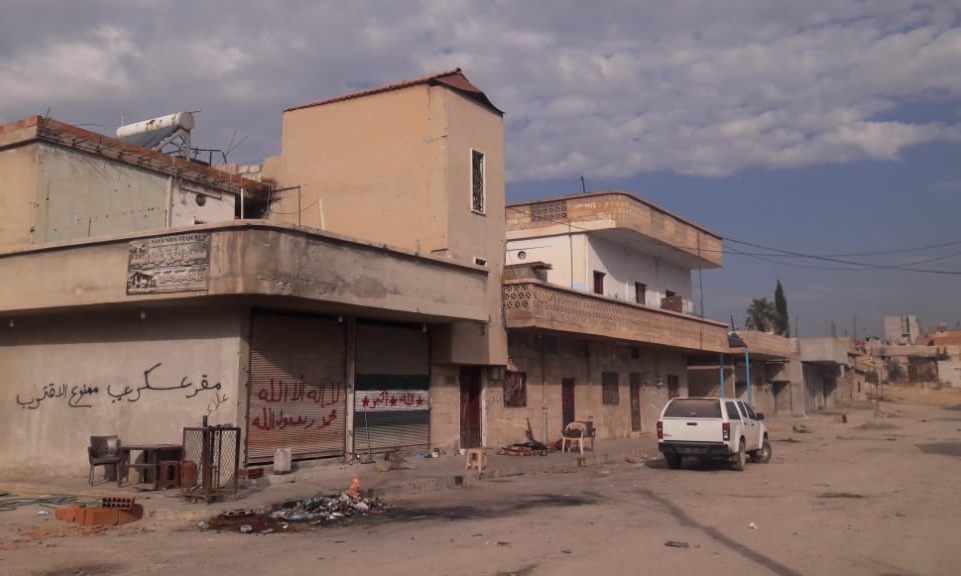Executive Summary:
Illegal destruction, occupying and property appropriation belonging to civilians, as well as preventing the return of Kurdish families who displaced due to Turkish military operations or blackmailing and threatening them are considered violations committed on a wide scale by Turkish forces and factions of the opposition Syrian National Army (SNA) in the areas of Afrin, Ras al-Ayn/Serê Kaniyê and Tall Abyad regions in Northern Syria, which are occupied by Turkey in Operation “Olive Branch” in 2018 and Operation “Peace Spring” in 2019.
In this report, Hevdesti-Synergy Association for Victims documents systematic and repeated patterns of looting and property appropriation belonging to civilians in “Peace Spring” and “Olive Branch” strips, especially those committed outside the context of the conduct of hostilities, such as the unlawful seizure, burning, sale or destroying real estates, and expelling the indigenous people and pushing them to leave the area.
Since the Turkish forces and the SNA’s factions entered Afrin, Ras al-Ayn/Serê Kaniyê and Tall Abyad regions, after the latter pillaged civilian properties, the SNA’s fighters and families occupied houses after civilians had fled or ultimately forced residents, especially the Kurds, to leave their homes, through threats, extortion, murder, kidnapping, torture and detention.[1]
As the SNA forces plundered and seized civilians’ properties in a coordinated manner, civilians claimed complaints to the military councils of those forces or to the local councils affiliated to the Syrian Interim Governments- which follows the National Coalition of Syrian Revolutionary and Opposition Forces in Afrin, Ras al-Ayn/Serê Kaniyê and Tall Abyad regions. However, the residents could not reclaim their properties. Moreover, members of the SNA threatened, extorted or detained many residents and other people were abducted and were forced to pay ransoms to leaders of the SNA factions to be released.
Types and patterns of property appropriation owned by civilians in Afrin, Ras al-Ayn/Serê Kaniyê and Tall Abyad regions varied. House walls were marked with the names of individual brigades or their leaders as signs the property was seized or marked with signs of appropriation as a clear indication that they prevented the return of the residents. The properties were occupied by families of the SNA fighters or used as military headquarters or administration institutions that follow the local councils without informing the owners or offering them compensations.
Turkish forces also were complicit in seizing and destroying properties and prevented the return of the residents, such as what happened in Dawoudiya village in the east of Ras al-Ayn/Serê Kaniyê, where the Turkish forces seized the Kurdish village and turned it to a military post after bulldozing many houses. They also transferred other houses to barracks for the Turkish soldiers to settle in. The Kurdish civilians were banned from returning to their village, or even burying their deaths in the village’s cemetery.
The Turkish government brought thousands of forcibly displaced Syrian families form other Syrian regions during the conflict and settled them in the indigenous people’s houses in Afrin, Ras al-Ayn/Serê Kaniyê and Tall Abyad. Many houses were vacated from their Kurdish inhabitants and family members of the SNA were settled in their seized houses. Hevdesti-Synergy verified the settlement of at least 55 families, including women and children of the Islamic State’s (ISIS) fighters, mostly Iraqis, in the appropriated houses in Ras al-Ayn/Serê Kaniyê.
One of the disastrous effects of such violations is changing the demographic of the Kurds-majority regions in Syria. This constitutes a growing concern for the people there especially in early May 2022, when the Turkish president Recep Tayyip Erdoğan announced that Ankara is drafting a plan to “voluntarily” return one million Syrian refugees to their own country.
Prior to this announcement, the Turkish government forcibly repatriated thousands of Syrians to Northern Syria despite international warnings that Syria is not safe. On 25 October 2021, Chair of the UN Syria Commission of Inquiry declared that “this is not a time for anyone to be thinking that Syria is safe, for its refugees to return home. Instead, we are seeing an upsurge in fighting and violence.[2]”
However, between 2019 and 2021, the Turkish government cancelled the kimlik (temporary protection Identification Document) to more than 155,000 Syrians and detained them at deportation camps adjacent to the Syria/Turkey border in order to later deport them to Syrian territories. Turkey alleges that the deportations it carries out are “voluntary”, but the Syrians’ testimonies who were deported deny that. There are reports confirming that Syrians in Turkey are subject to exploitation, extortion and threats of prolonged detention to force them to waive their residence permits.
Accounts collected for the purpose of preparing this report and hundreds of former ones documented by Hevdesti-Synergy in North and Northeast Syria confirm that property appropriation leaves catastrophic effects on the property owners and threatens their history and existence in the region they used to live in prior to displacement. It would be hard, if not impossible, for every person whose property, which he/she was investing or living in, was seized to stay in the area or to return to it later.
Settling Syrians from other governorates in Afrin and Ras al-Ayn/Serê Kaniyê where the indigenous people were coerced to displace, will lead to a demographic change in the region, undermine civil peace and common coexistence the region is characterized with. The scene will be more complicated if the issue is protracted and not addressed in the context of finding a comprehensive political solution to end the conflict in Syria.
Izz Adin Saleh, Hevdesti-Synergy Association’s Chief Executive Officer (CEO) said “property appropriation has got long-term and serious consequences during and after the conflict, which will have a significant impact on the return of displaced people and the refugees to their place of habitual residence. It is therefore important to draw the attention of the United Nations and the UN Security Council to the seriousness of this issue and press pressure on the Turkish government to stop such practices and hold the perpetrators accountable whether they are individuals or groups.”
Property Right in International Laws:
Property right is one of the human being’s essential rights endorsed by international covenants and charters. Article 17 of the Universal Declaration of Human Rights confirmed that everyone has the right to own property and stipulated that no one shall be arbitrarily deprived of his/her property. This right is closely linked to the right of the refugees and displaced persons to a voluntary return in safety to their places of habitual residence.
This right is underscored in Article 5 of the International Convention on the Elimination of All Forms of Racial Discrimination adopted in 1965 which stipulates the necessity to guarantee the right of everyone, without distinction as to race, color, or national or ethnic origin and the right to own property alone as well as in association with others. Noting that Syria and Turkey have ratified the agreement and they are bound by it.
The United Nations Guiding Principles on Internal Displacement asserted the need to provide protection, in all circumstances, to the displaced persons’ money and properties especially against pillage, direct and indiscriminate attacks and other acts of violence, the use of them as shields to military operations or objectives, being made the object or reprisal, and being destroyed or appropriated as a form of collective punishment. Property and money left behind by the displaced persons should be protected against destruction, arbitrary and illegal appropriation, occupation or use.[3]
International law prohibits the occupying power – Turkey in this case in parts of Northern Syria– from seizing private property in the occupied territories except in the case of urgent military necessity, which must be followed by compensation for the affected persons. Regardless of the reality of the occupation, the destruction and appropriation of an opponent’s property by one of the parties to the armed conflict is a violation of Customary Internarial Humanitarian Law (IHL) and may amount to a war crime, whether the armed conflict is international or non-international.
Displacement:
Every party to the armed conflict bears its legal responsibility for causing displacement of the civilian population during the armed conflict. The International Humanitarian Law (IHL) also prohibits it and this prohibition is one of the rules in of the Customary International Humanitarian Law. Removing the civilians out of their places of residence is not a legal evacuation unless there are imperative military reasons or the security of the civilians themselves is involved.[4]
However, the party that undertakes civilians’ displacement – legally as an evacuation or illegally as a displacement – bears a set of other legal obligations related to the protection of the displaced civilians as well as their rights including those related to reception and shelter, and the related guarantees for the protection of the right to housing, land and property and the right to return[5]. Forced displacement entails an individual criminal responsibility for what may amount to a war crime.[6]
The Right to Return:
“Displaced persons have a right to voluntary return in safety to their homes or places of habitual residence as soon as the reasons for their displacement cease to exist.”
Rule 132, the Customary International Humanitarian Law (IHL)
This right imposes on the competent authorities numerous legal duties mainly revolving around displacement as a temporary condition. It was also underlined in the UN Guiding Principles on Internal Displacement by charging the competent authorities- mainly those that undertook displacement- the primary duty and responsibility to create the conditions, as well as provide the means, which allow internally displaced persons to return voluntarily, in safety and with dignity.
Making hostilities, the military context and its necessities a pretext to push civilians to flee and leave them alone with their fate firstly contradicts the essence of the prohibition of displacement and secondly the obligations of the party undertaking displacement. The competent authorities bear the responsibility to conduct possible measures to guarantee the civilians and refugees’ right to return, including: measures that guarantee return in safety, most notably demining, provide assistance to cover the basic needs (shelter, nutrition, water, medical care), provide construction materials, kitchen tools, agricultural tools, seeds, fertilizers, repair of schools, skills and education training programs. There may also be measures that allow the displaced persons (or those representing them) to visit their places before their return to evaluate the situation related to security and material conditions.
Property appropriation belonging to refugees and internally displaced persons in Syria will undoubtedly constitute a stumbling block for their voluntary and safe return. The first thing that will come to their minds if they wish to return one day, is to live in their original houses or to invest in their lands. If nothing is said, their return would be meaningless.
Resolution 2254 of 2015 underscores “the critical need to build conditions for the safe and voluntary return of refugees and internally displaced persons to their home areas and the rehabilitation of affected areas, in accordance with international law.”
The refugees’ right to restore their possessions is affirmed in the principles mentioned by the UN Special Rapporteur Paulo Sérgio Pinheiro which are referred to shortly as “Pinheiro’s Principles”. It asserts that all refugees and displaced persons are entitled to restore any housing, land and/or property of which they were arbitrarily or unlawfully deprived of, or to be compensated for any housing, land and/or property that is factually impossible to restore as determined by an independent, impartial tribunal.
Recommendations:
After considering the issue of violating the housing, land and property rights in Northern Syria, notably in Afrin, Ras al-Ayn/Serê Kaniyê and Tall Abyad regions and based on the approach that focuses on victims and the survivors’ experiences, views, and priorities, Hevdesti-Synergy has concluded the following recommendations to the United Nations, the UN Security Council and the international actors in the Syrian affair:
- The United Nations and the UN Security Council should acknowledge that the Turkish existence in parts of the Syrian soil is an occupation in In accordance with Article 42 of the Laws and Customs of War on Land (Hague Convention) of 1907 and the Section III (Articles 47 to 78) of the Fourth Geneva Convention, to push Turkey to assume its responsibilities as an occupying power.
- Pressing pressure on the Turkish government to cease human rights violations its own forces or the Turkish-backed SNA forces are committing in the areas they occupy in Northern Syria and hold the perpetrators accountable, whether they are individuals or groups.
- Creating favorable conditions for the safe and voluntary return of refugees and internally displaced persons to their places of habitual residence and guarantee their right to restore their properties or compensating them for the properties that are factually impossible to restore, with the CSOs being part of this process.
- Governments and donor parties must ensure that their aid does not go to projects aiming to create demographic changes in the country, rather, the aid should be developed in projects that respect indigenous people’s rights and support their efforts to rebuild and strengthen their communities.
- Putting pressure on the Syrian National Coalition, the SIG and the forces in their command to stop the illegal appropriation of the residents’ properties in the areas under their control, most notably in “Peace Spring”, “Olive Branch” and “Euphrates Sheild” strips.
Background:
During the Turkish military invasion on areas in Northeast Syria dubbed Operation “Peace Spring” in October 2019, Turkey and Turkish-backed SNA factions directly bombarded civil buildings indiscriminately and plundered in a systematic manner private properties of the local people of different components, mostly the Kurds. The SNA’s factions also prevented hundreds of families who displaced due to the Turkish military operations to return to their homes. Prior to that, the Turkish military attack against Afrin in 2018 under the name Operation “Olive Branch” killed dozens of civilians and displaced thousands according to the United Nations. The SNA’s factions seized, looted, and destroyed properties of the Kurdish civilians in Afrin without compensating the owners and settled their fighters and their families in the civilians’ seized houses.
The two operations “Peace Spring” and “Olive Branch” caused the displacement of at least 350,000 residents of Afrin, Ras al-Ayn/Serê Kaniyê and Tall Abyad regions in North and Northeast Syria. More than 36,000 displaced people live in three makeshift camps (Washokani/ al-Twinah, Serê Kaniyê/al-Tala’i and Tall as-Samn) in the two governorates of al-Hasakah and Raqqa whereas more than 7,000 displaced persons live in makeshift camps in (al’Oda, Afrin, Shahba, al-Muqawama and al-‘Aser) which are run by the Autonomous Administration in Shahba region in the north of Aleppo governorate, according to Hevdesti-Synergy.
The regions occupied by Turkey as a result of the aforementioned operations are rife with countless of human rights violations perpetrated by Turkish forces and the Turkish-backed SNA’s factions. The documented violations include summary executions, enforced disappearance, property seizure, pillage and preventing the return of the residents, mostly the Kurds.
All of above, in addition to the lack of accountability and the persistence of impunity make the Turkish-occupied territories completely unsafe, contrary to Turkey’s propaganda, and do not comply with the criteria of voluntary return set by the United Nations.
On March 11, 2021, Hevdesti-Synergy released a report on the looting of agricultural crops and seizure of farmlands in “Peace Spring” strip and published another report on October 6, 2021 on the wide scale of pillage and plundering of properties in Ras al-Ayn/Serê Kaniyê. Hevdesti-Synergy submitted a complaint to the UN Special Rapporteurs on November 29, 2021 in regard to the appropriation of crops and farmlands by Turkey and the Turkish-backed armed groups in the areas they occupy in North Syria. Moreover, in May 5th 2022, in cooperation with its partners from the Syrian civil society, Hevdesti-Synergy organized an event parallel to the activities of the Sixth Brussels Conference with the aim to highlight violations of human rights and those related to housing, land, and property rights in Northern Syria from the victims’ perspective and the repercussions of such violations on the local communities in Syria.
In Pursuit of Redress for Victims:
Hevdesti-Synergy worked directly with the victims and documented their accounts and testimonies as a part of the Association’s strategy that focuses on experiences, perspectives and priorities of the victims, survivors and their families, in addition to seek multiple views to develop an analytical and an in-depth understanding of the events and commit to integrity and accuracy.
For the purpose of preparing this report, Hevdesti-Synergy relied on 20 concentrated accounts of victims who were subject to various patterns of housing, land and property rights violations in Ras al-Ayn/Serê Kaniyê, Tall Abyad and Afrin regions in Northern Syria. All of the accounts were collected from October 1 to December 1, 2022, in addition to the researchers’ analysis, images, documents, open-source information, analysis of visual evidences and the legal analysis.
The Association’s direct contact with tens of victims in Northern Syria during 2022 showed that the majority of the forcibly displaced people have low legal awareness on housing, land and property rights and the mechanism to defend such rights. In addition, hundreds of families were compelled to displace and had left behind their houses and properties as well as the documents proving their ownership, or that such documents got lost or are still incomplete because of conflict’s conditions of the conflict. Hence, many displaced persons lost their ability to restore their properties legally given they do not have the legal documents.
Therefore, Hevdesti-Synergy organized several awareness workshops during 2022, in areas and camps in Northeast Syria to raise the legal awareness and promote the capabilities of the forcibly displaced persons on “housing, land, and property rights” and types and degrees of the documents supporting ownership in Syria and the mechanisms to defend such rights in a legal way.
From the Association’s perspective, a comprehensive and sustainable peace in Syria won’t be achieved without addressing the issue of housing, land and property rights violations. Through this report and the other activities that the Association performs, we therefore attempt to provide a space/platform for the victims to be able to represent themselves and defend their rights with the aim to promote solidarity with victims of the housing, land and property rights violations in Northern Syria on the local and international levels.
Violations of Housing, Land and Property Rights in “Peace Spring” Strip:
Since the occupation of Ras al-Ayn/Serê Kaniyê and Tall Abyad regions in Operation “Peace Spring” October 2019, Hevdesti-Synergy has documented the seizure of more than 5,500 residential houses, 1,200 commercial and industrial shops and around one million donum (100,000 ha) of farmlands by Turkish forces and the opposition SNA. Also, 55 residential buildings were vacated from their indigenous people.
Other houses and properties were demolished, bulldozed and occupied in an illegal way, such as what happened in Dawoudiya village in the east of Ras al-Ayn/Serê Kaniyê when the Turkish forces seized the Kurdish village and turned it to a military post after bulldozing large numbers of houses and converting others to barracks for Turkish troops.
Dawoudiya follows the town of Abu Rasin/Zargan and it is known locally as “Dawoudiya Mella Salman”. The village used to contain (50-55) houses and the majority of its residents were from the Kurdish origin who were forcibly displaced duo to Operation “Peace Spring” before it was occupied by Turkish forces. The civilians were denied to return to their village or even bury their death in the village’s cemetery.
Following Operation “Peace Spring”, Dawoudiya village witnessed a heavy activity conducted by the Turkish forces which turned the village to a military post after the troops bulldozed and leveled to the ground two-thirds of the area in the village including the houses. The forces seized other houses like Sa’doun Salman’s house as well as his brothers’ houses and converted them into barracks for the 1st Commando Battalion affiliated with the Commando Brigade 49th in the Turkish forces, according to Anadolu News Agency.
Sa’doun Salman, 52, who hails from Dawoudiya village narrated to Hevdesti-Synergy the following:
“On October 18, 2019, Dawoudiya was completely evacuated from its inhabitants. With the intensity of the battles and the advance of the Turkish forces, all the residents displaced to al-Hasakah city. We kept looking for information about the village from our neighbors in the adjacent Arab villages as the majority of them did not leave. They told us that the Turkish forces had stationed in the village, and no one was allowed to approach it.”
Shortly later, Salman’s family learned from the residents of the nearby villages, that Dawoudiya village was transformed into a Turkish military post after the villagers’ houses were bulldozed. The family was ascertained of that when later news outlets circulated the information. Salman said:
“We watched on social media platforms and satellite imagery respectively that sand berms were installed around the village and positions for tanks and artillery were prepared. A Turkish channel published videos and images of the military post set up in our village. We saw that the Turkish troops put huge/long-term artilleries behind my house and my uncles’ ones and in the front side of the village.”
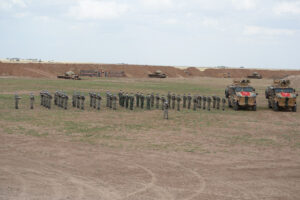

The image shows soldiers of the 1st Commando Battalion affiliated with the Commando Brigade 49th in the Turkish forces in the military post set up in Dawoudiya village in the east of Ras al-Ayn/Serê Kaniyê. Photo Credit: Anadolu News Agency.
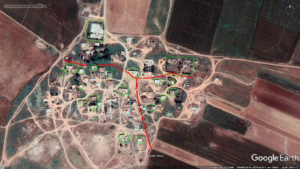
A satellite imagery showing the village of Dawoudiya on June 17, 2019 shortly prior the occupation.
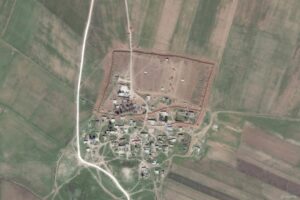
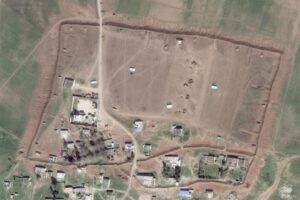
Images taken by Obretix showing Dawoudiya village shortly after its occupation. Photo Credit: Samir
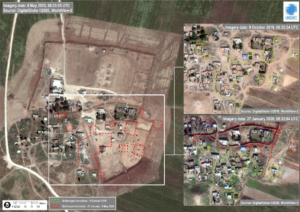
Satellite imageries showing the village of Dawoudiya on different dates before and after the occupation and transferring it to a military post by Turkey. The comparison between the images shows the houses bulldozed to establish the military post. Photo Credit: A report by the Independent International Commission of Inquiry on the Syrian Arab Republic released in September 2020.
-
An unfulfilled Bequest:
Salman’s family bore a big heartbreak after it failed to fulfill the bequest of one of its members who passed away in al-Hasakah and asked to be buried in his hometown in Dawoudiya. Salman narrated the story:
“Few months after our displacement, one of my uncles passed away in al-Hasakah city. He had asked to be buried in his hometown in Dawoudiya from which he displaced. We contacted some of our neighbors in the villages adjacent to Dawoudiya, and they showed their willingness to help to bury my uncle. They told us they would first ask the Turkish forces’ permission in the Dawoudiya village to let them hold the funeral ceremony.”
The family tried hard to fulfill the deceased’s bequest, but the Turkish troops stationed in the village refused and prevented them to return. Therefore, the deceased’s relatives buried him in a village in al-Hasakah city where they currently live after displacement.
The statements obtained by Hevdesti-Synergy show that the Turkish forces stationed in Dawoudiya had warned the villagers in the adjacent villages and farmlands not to approach Dawoudiya since it had become a military zone and asked them to inform residents of the Kurdish village of Dawoudiya not to think about returning to the village once again.
-
Loss of Hope to Return:
In conjunction with transferring Dawoudiya into a military post, the Turkish forces also bulldozed the properties in the village of Bab al-Faraj, where Kurds, Arabs and Syriac components lived together prior to the occupation. The forces converted the village’s houses to military posts and barracks for their troops and constructed a field hospital there, according to the villagers’ statements.
Hevdesti-Synergy interviewed the witness “Methher Mahmoud/an alias” who is one of the forcibly displaced persons from Bab al-Faraj. He told Hevdesti:[7]
“As soon as the [opposition] armed forces took control of Ras al-Ayn/Serê Kaniyê, they started to advance towards the east countryside. Then, we vacate the women and the children for their safety, however, we the men stayed the night in Abu Rasin/Zargan and returned to the village only during the day. We kept on this situation for one whole week.”
With clear sadness and sorrow on his face, Mahmoud recalled the moment he heard the news that his village was occupied:
“While I was in Abu Rasin/Zargan town, the neighbors told me that the armed forces had captured my village “Bab al-Faraj” and warned me not to return because of the news we used to hear about the violations the SNA’s factions committed in the areas they controlled. We therefore headed to al-Hasakah city leaving behind all of our properties, houses and agricultural tools including our warehouses that contained large amounts of wheat, cumin, and barley.”
Two months after the occupation of Bab al-Faraj, the villagers learned that Turkish forces had bulldozed some warehouses and properties and converted the houses into military posts and barracks for their soldiers and had also established a field hospital in the village. Mahoumed continued:
“We were hoping to return to our village, but unfortunately it never came true. The Turkish forces prevented the residents to return after the occupation and installed sand berms around the village and positioned tanks and heavy weapons there. We learned that the village had become a military post like that belonging to the Turkish forces near the contact lines/de-escalation zone in the countryside of Abu Rasin/Zargan.”
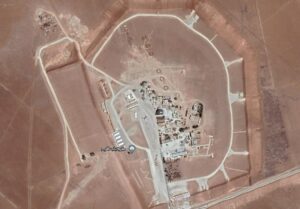

Satellite imagery showing the village of Bab al-Faraj on November 11, 2019 following the occupation and transferring it to a military post by the Turkish forces.
-
Murder Threats:
More than three years have passed since Turkey occupied the area stretching between Ras al-Ayn/Serê Kaniyê and Tall Abyad, yet “Ayman Ali/pseudonym[8]” is afraid to return to his village called “al-Safah” in the countryside of Ras al-Ayn as he continually received death threats from fighters in the SNA.
The witness is of Chechen origin, which is considered a minority in Ras al-Ayn/Serê Kaniyê. Currently, Ayman and his family live in the Autonomous Administration-held areas in Northeast Syria after he was compelled to displace form his hometown, al-Safah, due to the Turkish Operation “Peace Spring”. He spoke to Hevdesti-Synergy as saying:
“Prior to the onset of the Turkish military operation, some anonymous people threatened to execute me as soon as they enter the area. So, I was forced to displaced along with my family during the first moments of the operation, fearful for our lives.”
Ayman, 50, lost all his belongings and properties he left behind. They were all seized by the SNA’s factions, and Ayman was denied to return to his village because of the death threats. He narrated to Hevdesti-Synergy:
“All off my properties in the village were seized, including my house and farmland which is 135 donum (13,5 ha) allegedly on the pretext of my alleged Syrian Democratic Forces (SDF) affiliation. The SNA forces still occasionally threaten to kill me.”
The SNA’s fighters did not only seize the victim’s properties, but they also scorched a large part of his house and his brother’s one in al-Safah village. The fighters also invest his farmland and prevent him and his family from restoring their properties.
-
Selling the House of a Displaced Civilian:
During the Turkish attack on Ras al-Ayn/Serê Kaniyê in the Turkish Operation “Peace Spring”, few families decided to stay in their homes and not to displace despite the intensity of the battles for the purpose of save their properties from looting.
Those who stayed in the city thought that Turkish forces and the SNA’s factions won’t violate the civilians’ rights. The reality was different. The majority of those who preferred to stay in Ras al-Ayn/Serê Kaniyê and its countryside or those who returned later were interrogated by those forces. Other residents were subject to ill-treatment and torture on the pretext of formerly joining the Autonomous Administration and/or the SDF.
Hevdesti-Synergy interviewed the elderly man Abu Ali, 72, a resident of Ras al-Ayn/Serê Kaniyê who preferred to stay in the city during the military operations. He was arrested by the SNA. He narrated his story to Hevdesti-Synergy as saying:[9]
“I did not flee during the military operation to protect my family’s properties from pillage and looting. I am an elderly man, and I have no connections with any political or military party. But as soon as the military operations ended, a patrol of armed fighters affiliated with the al-Hamza/al-Hamzat Division stormed my house in the Mahat al-Shamali neighborhood. They blindfolded me and arrested me arbitrarily and told me nothing about the reason for my arrest.”
The witness/victim was taken to an unknown place. He was interrogated and released three days later. After that, he was arrested and interrogated for several times. He was subject to ill-treatment and torture. In this regard, he said:
“I was interrogated four times in a week. I was accused of dealing with the Autonomous Administration. I was severely beaten and tortured. When I was released in the fourth time, one of the fighters asked me to leave the region and to return again.”
The witness was forced to leave Ras al-Ayn/Serê Kaniyê and fighters from al-Hamza Division seized his house after plundering all its contents. Later, the witness learned that the fighters of al-Hamza Division had sold his house to a Syrian displaced person who was relocated to Ras al-Ayn by Turkey after the occupation. The al-Hamza Division fighters pretended the house was theirs and showed fake documents to the new buyer who later confirmed all that and who himself became a victim of the SNA’s fighters.
-
Denial of return:
After controlling Ras al-Ayn/Serê Kaniyê, the SNA’s factions soon started to commit violations against the civilians in a coordinated manner by looting and appropriating the residents’ properties and expelling the indigenous people and pushing them to flee.
On December 1, 2019, an elderly man returned to his city to check his properties, but he was surprised to find out that groups of the opposition SNA had confiscated his house and properties and prevented his return. He was threatened with arrest if he did not leave the city.
Hevdesti-Synergy interviewed the victim’s son who narrated the incident:[10]
“When my father returned to Ras al-Ayn/Serê Kaniyê, the SNA had confiscated our house and marked it with the name “seized for Abu Abdo” and “God is the Greatest/Allahu Akabar in Arabic” on its external wall. The neighbors told us that a leader known as Abu Abdo was now residing in our house and he had raised the Syrian Revolution’s flag on top of it.”
The SNA’s fighters prevented the witness’s father from entering his house or even checking it, alleging that his sons were dealing with the Autonomous Administration. The fighters threatened the elderly man of arrest and torture if he did not leave the area or if he ever thought about returning again. The witness added:
“The main purpose of this allegation was to seize our properties and prevent our return. In addition to our house, the SNA’s fighters had pillaged our shops in the industrial neighborhood and our farmland completely.”
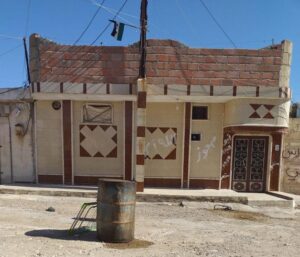
The image shows the SNA’s seizure of the elderly man’s house and marking its external wall with the phrase “seized” and raising the flag of the Syrian revolution on top of it. Photo Credit: the witness himself.
-
Fearful of Return:
In turn, Fares Khalaf, 52, is a displaced person from Ras al-Ayn/Serê Kaniyê who sighed for not being able to return to his city of Ras al-Ayn/Serê Kaniyê where he was born and lived before occupation. In this regard, he soke to Hevdesti-Synergy:
“My family and I displaced with the onset of the Turkish attack on Ras al-Ayn/Serê Kaniyê on October 9, 2019. Like any other Kurdish man, I am frightened to return since then because I am afraid of being arrested or subjected to other violations given the SNA’s record which is rife with human rights violations in the areas they control.”
The SNA’s factions seized the witness’s whole properties. He said:
“The Sultan Murad Division confiscated my two-story house located in Zaradasht neighborhood in Ras al-Ayn/Serê Kaniyê after looting all of its contents. They transferred the house to a warehouse for collecting the looted contents of other houses in the neighborhood. The Division also pillaged my shop located in the industrial neighborhood. My shop contained thousands of spare parts for agricultural machines.”
The witness is now a displaced person living in Qamishli/Qamishlo city after he lost all his properties and belongings. He said that he was not thinking about returning to Ras al-Ayn/Serê Kaniyê especially that insecurity and armed chaos spread in the “Peace Spring” strip.
-
Converting a Clinic into a Security Headquarter:
The scene in Tall Abyad city was not much different from Ras al-Ayn/Serê Kaniyê given factions of the opposition SNA adopted the same pattern, which is seizing properties of civilians, from different components, and preventing Kurdish families from returning to their places of habitual residence.
Hevdesti-Synergy interviewed many forcibly displaced people from Tall Abyad and documented their accounts and testimonies. One of them is the doctor “Ali Othman” who used to practice his profession routinely in the city before the Turkish military operation took place.
Othman, who currently lives in Raqqa, talked to Hevdesti-Synergy about the SNA’ seizure of his properties in Tall Abyad city.
“A week after my displacement, the SNA’s factions controlled the city and seized my house and clinic. They converted my clinic to a security headquarter after stealing all the medical equipment. My house as well as other nearby houses were converted to military headquarters.”
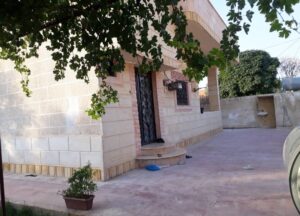
An exclusive image to Hevdesti-Synergy showing the house of the doctor “Ali Othman” located in Tall Abyad city before it was seized in the Turkish Operation “Peace Spring”. Photo Credit: the witness Ali Othman.
-
Demolishing Houses of Displaced Persons in Reprisal Operations:
Another witness who hails from the south countryside of Tall Abyad narrated to Hevdesti-Synergy how the SNA seized his house and demolished it completely.
“A week after I displaced from my village (Hawija Abdi) due to the Turkish Operation (Peace Spring), the SNA’s fighters seized my house and farmland in the village. Later, the neighbors told me that the armed factions had demolished my house completely after looting all of its contents.”
The witness added that the SNA’s factions had confiscated two houses that belonged to his relatives after pressing charges against them of dealing with the SDF.
Based on the witness’s statement, Hevdesti-Synergy communicated with other villagers from “Hawija Abdi” located in the south of Tall Abyad where many more property seizure operations took place. Hevdesti-Synergy interviewed the 25-year-old Mahmoud Abdu/pseudonym, who displaced to Raqqa. He said:
“The SNA’s factions seized my house in the village and demolished it with a bulldozer. They also destroyed my father’s house as well as other houses that belonged to my relatives in reprisals because some of our family members used to work with the Autonomous Administration of North and East Syria (AANES).”
According to the statements obtained by Hevdesti-Synergy, many violations of the housing, land and property rights committed in “Peace Spring” strip were committed with the aim to take revenge from the owners. The properties were either seized, scorched or destroyed allegedly because the owners supported or joined the Autonomous Administration, or that they left the region or often for being Kurds, Yazidis or from other minorities.
Property Appropriation in “Olive Branch” Strip:
Property seizure in Afrin region started as soon as Turkey controlled the area. Social media platforms circulated many images showing fighters of the opposition SNA looting residential houses and shops after they entered the city on March 18, 2018. The Agence-France Press (AFP) published images of fighters of the Syrian factions opening shops, houses, and restaurants and looting food and electronics among other materials before transferring them outside Afrin. The images showed the factions’ fighters looting vehicles and agricultural machines left behind by the forcibly displaced people.
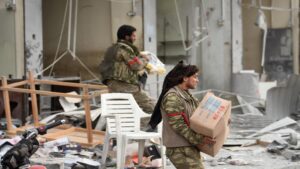
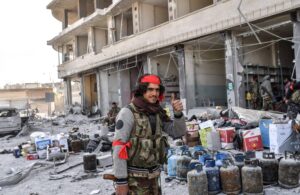
The images showing the SNA’s fighters looting civilians’ belongings in Afrin after it was occupied by Turkey on March 18, 2018. Photo Credit: AFP.
After Turkey occupied Afrin, it handed over its administration to the SNA’s factions which soon started to seize properties and belongings of the Kurdish civilians in Afrin, destroying and looting them without compensating their owners and settled the SNA’s fighters and their families in the seized houses as well.
Hevdesti-Synergy interviewed a witness from Rajo district in the countryside of Afrin who was forcibly displaced to Aleppo due to the Turkish Operation “Olive Branch”. He talked about the fate of his properties and belongings he had left behind:[11]
“Almost a month after Turkey and the armed opposition factions took control of the region, I received a phone call from my neighbor who had returned to Afrin city and was arrested, beaten and tortured. He told me that Ahrar al-Sharqiya (Free Men of the East) faction had seized my orchard after the fighters cut off all olive trees.”
The witness/victim said he never thought to return back to his home town fearful of arrest and/or killing at the hands of the Turkish forces or the SNA’s factions. His properties are still confiscated by the SNA’s forces, and he is unable to reclaim them.
Property seizure were not limited to specific factions of the opposition SNA as most of the factions participated in pillaging and looting the properties. Other houses and properties were demolished in the hostilities during the Turkish Operation “Olive Branch”.
Rezan Khalid, a pseudonym, is a 53-year-old man who displaced from Hauzan/Qortagh village in Bulbul district in the countryside of Afrin. He talked to Hevdesti-Synergy about the loss of his house and property in Operation “Olive Branch”[12].
“After I was displaced to Aleppo in early February 2018, I kept in touch with my neighbors who stayed in Afrin or with those who returned later. I learned that my house was demolished completely as it was struck by Turkish warplanes in late February 2018 after all its contents were looted by the Sultan Murad Division which was stationed in the village after the occupation.”
-
She Lost Her Son and Her House at the Same Time:
The family of the 47-year-old female known as Shireen/pseudonym experienced tough times during the Turkish attack against their town in Afrin countryside. One of the sons were killed in the Turkish bombardment and Shireen’s house was seized after they were compelled to displace.[13]
The heartbroken mother narrated to Hevdesti-Synergy the moment her son was killed:
“On the 35th day of the onset of the Turkish military operation, a shell dropped on the automatic bakery in Sharran district and several civilians were missed including my 19-year-old son who had gone to buy some bread. He went and never came back. We could not find his body because it was scattered to many pieces.”
On February 25, 2018, the family displaced from its hometown in Sharran after the Turkish bombardment intensified on Afrin countryside. The family fled leaving all their belongings and properties behind. They only carried with them a deep sorrow for the loss of their son whom they had not even had the chance to bury him in peace.
It was April 2018 when the family received news that Sultan Murad Division had seized all their properties and belongings and had placed their fighters and families in the seized house. The witness Shireen added:
“We were deeply sad for the loss of my son, my most precious thing in my life. We Later learned that fighters of the Sultan Murad Division had seized our properties and had settled their families in them. At that time, we felt even worse. The neighbors also told us that at first our house was converted to a prison, but six months later it was handed over to a fighter of the division and now he is residing in our house with his family after all the contents were looted.”
-
Property Appropriation and Threat:
The 47-year-old man Sheikho Walid/an alias, received a phone call from a fighter of the opposition SNA in Afrin, following its occupation by Turkey in March 2028, asking him to pay a financial ransom so that his properties and orchards won’t be confiscated and gave him a fixed deadline to deliver the ransom; Walid’s orchards and properties stretch on a vast area of Afrin countryside.[14]
The witness refused to pay the ransom and detailed to Hevdesti-Synergy the story:
“Five days after the deadline expired, and refusing to pay the ransom, one of my neighbors called me and told me that the armed forces had confiscated one of my plants and converted it to a stockyard for the livestock they had stolen from Afrin countryside.”
In late March 2018, one fighter of Ahrar al-Sharqiya faction seized Walid’s residential house in Afrin because he could not return to check his properties fearing the consistent threats by the opposition SNA’s factions to imprison and torture him. He added:
“I was not thinking about going back to Afrin, so I asked one of my relatives there to check my house and to send me a photo of it. He refused and told me that no one could approach the house after it was seized. Everyone who would try to do so would be imprisoned and tortured and would be consequently forced to pay financial ransom for his freedom.”
The witness/victim added that only 50 Kurdish families stayed in Rajo district, from which he hails. More than one thousand families used to live there before Operation “Olive Branch”. The violations Turkish forces and the SNA’s factions perpetrate there pushed the residents to flee and rendered them unable to return.
-
Plundering Kurdish Heritage:
The 66-year-old fine artist “Hanif Othman Hamo” recalls some of his artistic paintings on the Kurdish heritage which were looted and pillaged. Hamo’s house located in Masikan/Moskah village, in Rajo district that follows Afrin countryside, was also seized. In this regard, he spoke to Hevdesti-Synergy:
“I still remember that moment in April 2018 when one of my neighbors told me that a fighter in a faction of the SNA had seized my house in the village. My house was surrounded with fruitful olive trees.”
Hamo’s paintings, through which he narrates the Kurdish culture, represent a valuable historical heritage to him. However, many of them were vandalized and stolen on purpose. The witness currently is living in Aleppo city where he and his family displaced to as a result to the Turkish Operation “Olive Branch”. Hamo told Hevdesti-Synergy that he was afraid to go back to Afrin:
“We decided not to go back and live under the control of the Turkish army and the opposition armed groups due to the violations they commit against the Kurdish populations who return to their homes.”

The image shows the fine artist “Hanif Hamo” in his atelier in his own house in Masikan/Moskah village located in Rajo district, Afrin countryside, prior to the Turkish occupation in 2018. Photo Credit: The witness Hanif Hamo.
-
Challenges of Returning:
The forcibly displaced people of Afrin did not have the chance to check their properties after they were seized as a result of Turkish Operation “Olive Branch”. For instance, the house of “Ramzi Rashid”, 67, in the village of Meidan Ekibs in Rajo district was seized.
Rashid learned from his neighbors that his house was confiscated and that a family of one of the fighters of the SNA was settled in it. In this regard, he told Hevdesti-Synergy:
“One of the neighbors who returned home after the occupation told me that a fighter of the SNA had seized my house and that he was residing in it with his family. I had planted about 20 citrus trees around my house including oranges, mangos, pomegranates, apples, pears and figs trees.”
The witness is currently living in Babins village in Shahba area in the north of Aleppo which is under a joint control by the People’s Protection Units (YPG) and the Syrian government forces. The witness illustrated that he can’t go back home fearful for his life. He said:
“A year after Afrin was occupied, in 2019, I phoned one of my neighbors and asked him to check my house from inside. When the neighbor tried to do that, the fighter who was residing in the house prevented him. He expelled him and threatened to arrest him if he ever tried to repeat that and to arrest me if I ever thought of return.”
In addition to seizing the witness’s house, other houses belonging to the forcibly displaced people from Meidan Ekibs town in Rajo district were destroyed during Operation “Olive Branch” without compensating the owners, according to the villagers’ statements obtained by Hevdesti-Synergy.
In another incident, Amina Badran/pseudonym, learned that her house was set on fire and that their orchard in al-Matla/Zarga village in Rajo district was seized by fighters of the opposition SNA[15].
Bdran, 51, told Hevdesti-Synergy the story:
“A month after we displaced as a result of the Turkish operation “Olive Branch”, specifically in April 2018, my brother-in-law returned and was shocked that his two brothers’ houses were seized and set on fire, one of them was ours. He found out that the SNA’s factions had also seized my husband’s orchard that contained 35 fruitful olive trees.”
The fighters who seized the orchard warned the witness’s brother-in-law telling him not to approach the orchard once again and that he would be arrested and tortured to death if he ever returned to the region.
Hevdesti-Synergy spoke to another witness from Rajo in Afrin countryside who said:
“Because of the violations the armed factions are committing against the Kurdish population who returned to their lands and properties, I decided not to go back. Therefore, I lost my orchard which is 58,000 square meters and which contained around 350 6-year-old olive trees, in addition to six shops that contained houses decoration materials and supplies that are estimated to 70,000 USD.”
Factions affiliated with the SNA committed the majority of housing, land and property rights violations in Afrin region. In most cases, the victims could not identify accurately the specific faction responsible for the violation. For instance, Shukri Hamo/pseudonym, is a 72-year-old man whose house, gas station, a factory for construction materials, and car wash in Sharran district were all seized. He could not identify the faction that was responsible for the seizure of his properties.[16]
He told Hevdesti-Synergy:
“The armed factions seized all of my and my sons’ properties. I learned that they rented my gas station to one of the displaced persons who was relocated by Turkey to the region following the occupation.”
The witness expressed his concerns to return to Afrin notably that one of his relatives was arrested and tortured after he returned on charges of dealing with the Autonomous Administration and/or the SDF.
The majority of the forcibly displaced people who Hevdesti-Synergy interviewed said they feared to back to their places of habitual residence or even to check their properties and belongings after displacement because they fear to be arrested and tortured at the hands of the Turkish-backed opposition SNA due to the consistent human rights violations committed in the Turkish-controlled regions in Northern Syria and that those responsible for such violations are unpunished, in addition to the lack of effective redress mechanisms.
————-
[1] This was documented in the report released by the International Commission of Inquiry on the Syrian Arab Republic in September 2020, para 46. (Last accessed: December 26, 2022).
[2] Syria: UN Commission Chair warns the General Assembly that war against the Syrian people continues unabated, the United Nations, October 25, 2021. ‘Last accessed December 26, 2022)
[3] Principle 21 of the Guiding Principles on Internal Displacement adopted in Austria in 1998, endorsed in the 54th session of the Human Rights Committee. (Last accessed December 26, 2022).
[4] ICRC, Database of the IHL, rules of the Customary International Humanitarian Law, rule no 129. (Last accessed December 26, 2022).
[5] ibid.
[6] The Rome Statute of the International Criminal Court, article 8 (2) (e) (viii).
[7] The witness’s information is withheld upon his request.
[8] The witness’s information is withheld upon his request.
[9] The witness’s identity and some of his information are withheld upon his request.
[10] The witness’s identity and some of his information are withheld upon his request.
[11] The witness’s information is withheld upon his request.
[12] The witness’s identity and some information are withheld upon his request.
[13] The witness’s information is withheld upon her request.
[14] The witness’s information is withheld upon his request.
[15] The witness’s information is withheld upon her request.
[16] The witness’s information is withheld upon his request.

